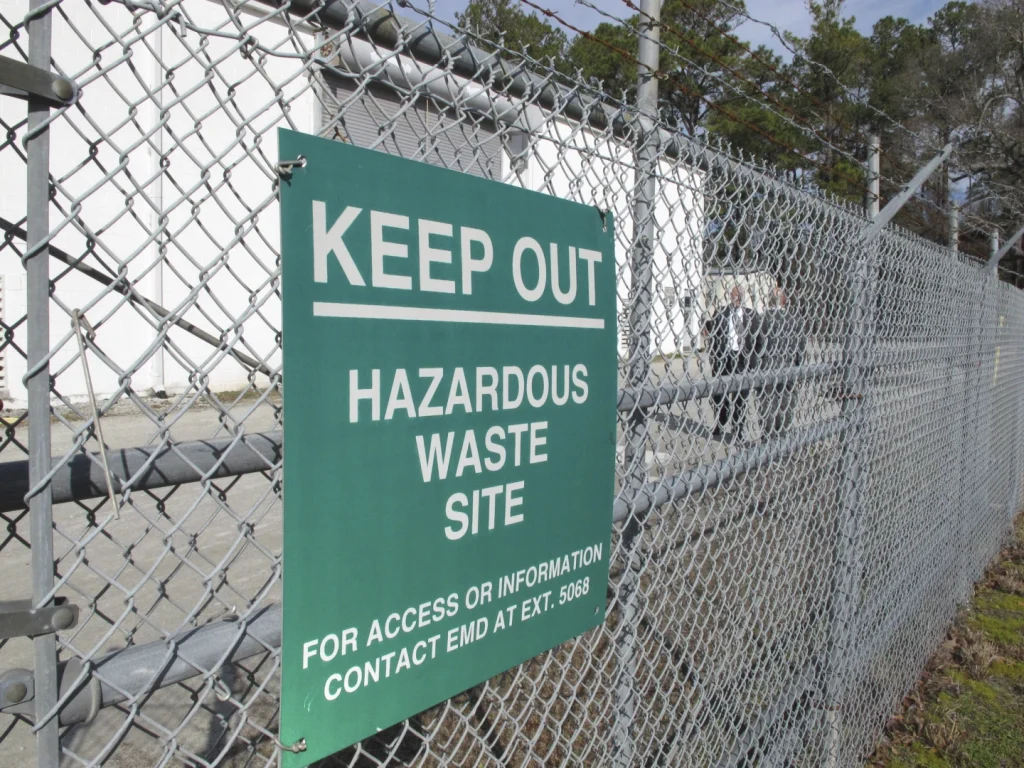The recent study conducted by federal health officials on the health risks faced by military personnel stationed at Camp Lejeune from 1975 to 1985 has brought to light some alarming findings.
According to the study, individuals stationed at the North Carolina base during that time period had a significantly higher risk of developing certain types of cancers compared to those stationed elsewhere.
This revelation has sparked widespread concern and calls for further investigation into the potential causes and implications of this elevated risk.
The study, which has been described as one of the largest ever conducted in the United States to assess cancer risk in a polluted environment, compared the health outcomes of individuals who lived and worked at Camp Lejeune to a similar group that did not.
The findings revealed that military personnel at the U.S. Marine Corps Base Camp Lejeune faced a heightened risk for several types of cancers, including leukemia, lymphoma, lung cancer, breast cancer, throat cancer, esophageal cancer, and thyroid cancer.
Additionally, civilians who worked at the base were also found to be at a higher risk for a shorter list of cancers.
These findings have raised serious concerns about the potential health hazards associated with the contaminated drinking water at Camp Lejeune during the specified time period.
It is imperative that further research be conducted to determine the extent of the health risks faced by individuals who were stationed at the base, as well as the potential long-term effects on their health and well-being.
In light of these findings, it is essential that the Department of Defense and other relevant authorities take swift and decisive action to address the health concerns of military personnel and civilians who were exposed to the contaminated drinking water at Camp Lejeune.
This may include providing comprehensive medical screenings and support services to those who may have been affected, as well as implementing measures to prevent similar incidents from occurring in the future.
Furthermore, it is crucial that the findings of this study serve as a catalyst for broader discussions about the environmental and health risks faced by military personnel and civilians at other military installations across the country.
It is imperative that steps be taken to ensure the safety and well-being of those who serve their country, both during their time of service and in the years that follow.
In conclusion, the recent study on the elevated cancer risk faced by military personnel stationed at Camp Lejeune from 1975 to 1985 has shed light on a pressing public health issue that demands immediate attention and action.
It is essential that the findings of this study serve as a catalyst for further research, advocacy, and policy changes to protect the health and well-being of those who have dedicated their lives to serving their country.
The implications of this study are far-reaching, and it is incumbent upon all stakeholders to prioritize the health and safety of military personnel and civilians who may have been exposed to similar risks.
The issue at hand is indeed a complex and multifaceted one, as articulated by the statement, “This is not something we’re going to be able to resolve definitively.”
The historical context of the matter, involving exposures that transpired decades ago and were inadequately documented, further complicates the pursuit of a comprehensive resolution.
Nonetheless, the forthcoming research endeavors are poised to bolster the assertions advocating for individuals who fell ill subsequent to their residence or employment at the base.
The origins of Camp Lejeune, established amidst a sandy pine forest on the North Carolina coastline in the early 1940s, are intertwined with the disconcerting revelation of industrial solvent contamination in its drinking water from the early 1950s until 1985.
This contamination, which was identified in the early 1980s, was attributed to the negligent maintenance of a fuel depot, indiscriminate dumping on the base, and the activities of an off-base dry cleaner.
Prior to the cessation of well usage, the tainted water was distributed to various facilities, including barracks, offices, housing for enlisted families, schools, and the base’s hospital.
The implications of this situation are far-reaching, as military personnel and their families unwittingly consumed, cooked with, and bathed in this contaminated water.
The resultant litigious climate, characterized by the proliferation of legal actions spearheaded by law firms through televised advertisements, underscores the gravity of the situation.
Those who have suffered adverse health effects subsequent to their time at Camp Lejeune have leveled accusations against the Marine Corps for its purported failure to safeguard the well-being of its personnel, while also castigating the federal government for its perceived sluggishness in conducting investigations.
In response, Marine Corps officials have consistently contended that the federal environmental regulations pertaining to the carcinogenic chemicals in question were not formalized until 1989, subsequent to the discontinuation of well usage.
The involvement of the Agency for Toxic Substances and Disease Registry (ATSDR), an Atlanta-based sister agency to the Centers for Disease Control and Prevention (CDC), in conducting approximately six studies focused on health issues among individuals at Camp Lejeune has been a significant facet of the response to this crisis.
While these previous studies were characterized by their relatively limited scope and diverse emphases, such as male breast cancer rates and birth defects in offspring of base personnel, they did underscore the existence of health risks.
The impending research, however, is poised to offer a more comprehensive understanding of the situation, as emphasized by Richard Clapp, an emeritus public health professor at Boston University who has been involved in prior Camp Lejeune research.
Furthermore, Dr. Aaron Bernstein, the director of the ATSDR and CDC’s environmental health programs, has lauded the forthcoming study for its remarkable scale and heightened rigor in comparison to previous research endeavors.
In a recent paper, the Agency for Toxic Substances and Disease Registry (ATSDR) undertook an investigation into cancer cases among approximately 211,000 individuals who were stationed at or worked at Camp Lejeune between 1975 and 1985.
The study compared this group to around 224,000 individuals at California’s Camp Pendleton, which was not known to have contaminated groundwater, during the same time period.
Frank Bove, a senior epidemiologist, spearheaded the agency’s research on Camp Lejeune for several years and oversaw the latest study.

He collaborated with staff at Battelle Memorial Institute and others to meticulously examine cancer registries nationwide in search of cases associated with either base.
The findings revealed a comparable number of malignant cancers in each group, approximately 12,000. However, the relative risks calculated from these numbers were notably higher in the Camp Lejeune population for various specific types of cancer, including some that had not been clearly identified in prior studies, particularly thyroid cancer.
A federal law signed by President Joe Biden in August 2022 addressed concerns of individuals who developed certain health issues they believed were linked to Camp Lejeune water contamination, granting them a two-year window to file claims.
The new study’s implications may result in the potential inclusion of thyroid cancer in the list of diseases for which Camp Lejeune personnel and their families could someday receive compensation.
The paper, having undergone external peer review, is currently being submitted for publication, as confirmed by agency officials.
